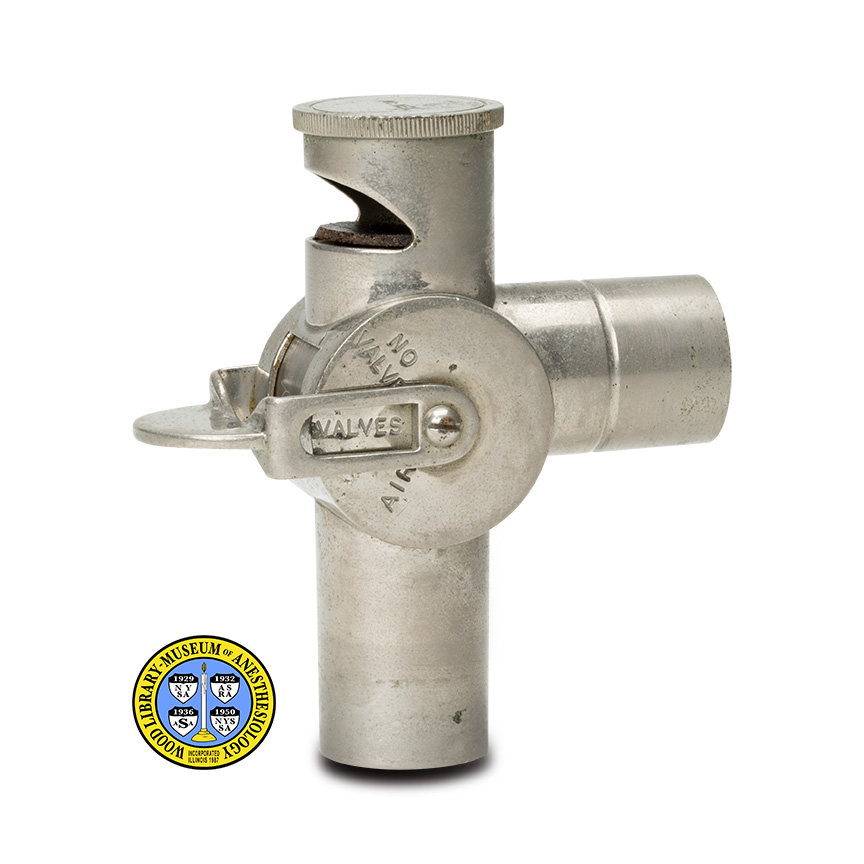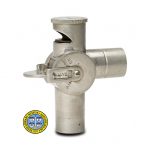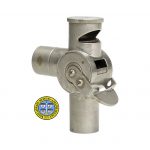Barth Three Way Stopcock
Some of the earliest anesthesia devices, including the Morton Ether Inhaler and the Snow Chloroform Mask, were equipped with valves that directed the flow of anesthetic gas and air to and from the patient. Separate stopcocks for this purpose were introduced in the 1860s. These could be purchased alone or together with a mask made of leather, rubber or celluloid.
The three-way stopcock shown here was introduced by the London manufacturer, George Barth & Company. This example, made by McNeil, probably dates from the 1930s. The short tube was connected to a mask that would be placed over the patient’s nose and mouth. The longer tube was connected to a rubber re-breathing bag that would be filled with nitrous oxide gas.
The stopcock has three settings which are controlled by a lever. The “No Valves” setting allowed the patient to inhale only from the re-breathing bag, and directed his exhaled breath into the bag. Each exhalation added carbon dioxide to the gas mixture. The “Valves” setting allowed the patient to inhale only from the bag, while his exhaled breaths were directed away from the bag through a one-way expiration valve. The “Air” setting closed off the bag, so that the patient would breathe to and from only the surrounding air.
Catalog Record: Barth Three Way Stopcock
Access Key: alup
Accession No.: 2005-11-13-2
Title: [Barth-type three way stopcock.]
Corporate Author: George Barth and Company
Title variation: Alt Title
Title: Barth three-way nitrous oxide tap.
Title variation: Alt Title
Title: Barth’s three way stopcock.
Publisher: [Place of manufacture not identified] : [Mc Neil], [between 1890 and 1940?].
Physical Descript: 1 valve : metals ; 8 x 9 x 4 cm.
Subject: Anesthesia, Inhalation – instrumentation.
Subject: Nitrous Oxide.
Note Type: General
Notes: Title is based on descriptions in Luke (1905) and the Claudius Ash catalog
(1908), cited below.
Note Type: General
Notes: The range of dates of possible publication is based on the appearance of
Barth stopcocks in titles in the Wood Library-Museum’s collection. It
appears in catalogs dating from 1892 through 1930, and in textbooks dating
from 1903 through 1940.
Note Type: Citation
Notes: Claudius Ash & Sons. Ltd. Appendix to 1886 Dental Catalogue. London:
Claudius Ash & Sons; 1892:230-231.
Note Type: Citation
Notes: Claudius Ash & Sons, Ltd. Catalogue Of Artificial Teeth, Precious Metals,
Stoppings, Dental Rubbers, Furniture, Instruments, Nitrous Oxide Gas and
Ether Apparatus, Laboratory Apparatus, Tools And Sundries. London: Claudius
Ash & Sons; 1893:440-441.
Note Type: Citation
Notes: Dental Manufacturing Co., Ltd. Catalogue of Mineral Teeth, Dental Rubbers,
Furniture, Instruments, Precious Metals, Stoppings, Electrical Apparatus,
Apparatus For The Production of Anaesthesia, Drugs And Chemicals, Workroom
Apparatus, Tools And Sundries. London: Dental Manufacturing Co. Ltd.;
1899:246-247.
Note Type: Citation
Notes: Luke TD. A Guide to Anaesthetics For The Student and General Practitioner.
2nd ed. Edinburgh: William Green & Sons; 1905:16-19.
Note Type: Citation
Notes: Claudius Ash, Sons & Co., Ltd. Anaesthetic apparatus: list K. London:
Claudius Ash, Sons & Co., Ltd.; June, 1908:26-27. In: Catalogue. [London] :
Claudius Ash & Sons; [ca. 1909].
Note Type: Citation
Notes: Buxton, DW. Anaesthetics Their Uses And Administration. 6th ed.
Philadelphia: P. Blakiston’s Son & Co.; 1920:79-81
Note Type: Citation
Notes: Boyle, HE, Hewer CL. Practical Anaesthetics. 3rd ed. London: Henry Frowde
and Hodder & Stoughton; 1923:53-58.
Note Type: Physical Description
Notes: One valve; The measurements for the physical description were taken treating
the side bearing the control markings as the front of the device; The top of
the central tube of the stopcock is closed with a flat cap (marked “McNeil”);
The bottom, open end of the central tube would connect to a rebreathing bag;
near the top of the central tube, on the side distal to the patient, there is
an expiratory valve; This valve consists of a crescent-shaped opening in the
tube, with a rubber disk seated at the bottom of the opening; It resembles a
steam whistle; In the middle of the central tube there is a cylindrical
mixing chamber; this is equipped with a control lever that has three
settings; The lever wraps around the back of the chamber, and is affixed to
it by a screw on each side; A flat plate in the center of the lever, directly
under the expiratory valve, is used to adjust the lever’s position; the marks
for the settings appear on the left side of the chamber (from the patient’s
perspective); Emerging from the front of the mixing chamber is a tube that
would connect to a mask; This tube joins the central tube at a right angle,
forming a “T”; In the back of the chamber (directly under the expiratory
valve) there is an aperture to the air; A sliding metal plate inside the
chamber, controlled by the lever, is raised or lowered to open and close the
following features: the air aperture in the back of the chamber, the tube
that leads to a mask, and the tube that leads to a rebreathing bag; The first
control setting (closest to the expiratory valve) is marked “No Valves”; When
the lever is centered on this setting, it can move no further upward; with
the lever in this position, the sliding plate has closed the air aperture in
the back of the chamber, and partially opened both that tube leading to a
mask and that tube leading to a rebreathing bag; at this setting the patient
both inhales from and exhales to the rebreathing bag; The control setting in
the middle (opposite to that tube leading to a mask) is marked “Valves”; When
the lever arrives at this setting, it makes a distinct “click” sound; With
the lever in this position, the sliding plate has closed the air aperture,
partially opened that tube leading to a mask, and fully opened that tube
leading to a rebreathing bag; This directs the patient’s exhaled breath to
the expiratory valve; The third control setting is marked “Air”; When the
lever is centered on this setting, it can move no further downward; With the
lever in this position, the sliding plate has fully opened both the air
aperture at the back of the chamber and that tube leading to a mask, while it
has closed that end of the tube leading to a rebreathing bag; This permits
only air to flow to the mask.
Note Type: Reproduction
Notes: Photographed for the WLM by Mr. Steve Donisch, January 12, 2015.
Note Type: Historical
Notes: Some of the earliest anesthesia devices, including the Morton Ether Inhaler and the Snow Chloroform Mask, were equipped with valves that directed the flow of anesthetic gas and air to and from the patient. Separate stopcocks for this purpose were introduced in the 1860s. These could be purchased alone or together with a mask made of leather, rubber or celluloid.
The three-way stopcock shown here was introduced by the London manufacturer, George Barth & Company. This example, made by McNeil, probably dates from the 1930s. The short tube was connected to a mask that would be placed over the patient’s nose and mouth. The longer tube was connected to a rubber re-breathing bag that would be filled with nitrous oxide gas.
The stopcock has three settings which are controlled by a lever. The “No Valves” setting allowed the patient to inhale only from the re-breathing bag, and directed his exhaled breath into the bag. Each exhalation added carbon dioxide to the gas mixture. The “Valves” setting allowed the patient to inhale only from the bag, while his exhaled breaths were directed away from the bag through a one-way expiration valve. The “Air” setting closed off the bag, so that the patient would breathe to and from only the surrounding air.
Note Type: Exhibition
Notes: Selected for the WLM website (Noted March 30, 2015.)



